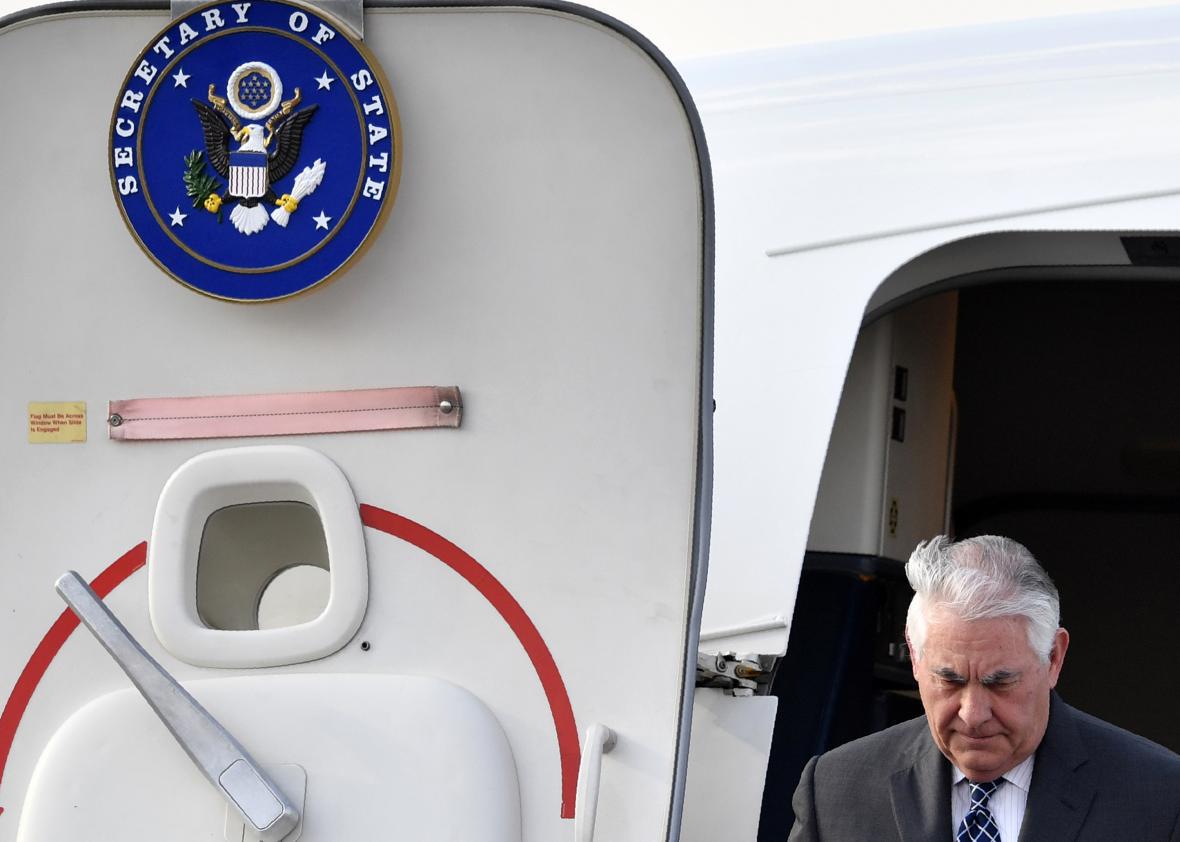What a difference three weeks makes. When Secretary of State Rex Tillerson’s visit to Moscow was first announced in March, the Trump administration was accused of once again snubbing NATO—which was holding a summit several days earlier that Tillerson initially planned to skip—in favor of Russia. Way back then, it was generally assumed that Tillerson and the administration saw the ongoing war in Syria in a broadly similar way as Russia did: the priority was to fight ISIS and Bashar al-Assad wasn’t going anywhere. The ongoing investigation into Russia’s role in the U.S. election did not help the perception that the administration was overly deferential to Moscow.
Tillerson is still on his way to Russia this week, but the optics, at least, have changed quite a bit. Following last week’s airstrike on Assad’s air force in response to a chemical weapons attack, President Trump is now being blasted by the once-friendly Russian media. According to Reuters, he is also now carrying “a unified message from world powers to Moscow … denouncing Russian support for Syria and taking up America’s traditional role as leader of the West.”
Well … maybe. Tillerson has had strong words for Vladimir Putin’s government recently, calling it either “complicit” or “incompetent” in relation to Assad’s use of chemical weapons. As for articulating the Trump administration’s exact strategic goals in Syria, though, the signals have been mixed, with the secretary of state contradicting other members of the administration, and sometimes himself.
It was Tillerson who, on March 30, signaled that Assad’s removal was no longer a U.S. priority when he said that the “longer-term status of President Assad will be decided by the Syrian people.”
Then, on Wednesday, shortly after Trump had expressed dismay at the civilian casualties following the chemical attack in Idlib, Tillerson abruptly reversed course saying that, there was “no role for [Assad] to govern the Syrian people” and that steps were underway to remove him. He noted, however, that the priority was still fighting ISIS and that “the process by which Assad would leave is something that would take an international community effort.” This was essentially the Obama policy on Syria, which Trump spent months on the campaign lambasting. A few hours after that, of course, the U.S. unilaterally launched its missile strike.
Tillerson’s more recent statements seem to indicate that the administration’s hope is that the strikes were a one-off response to the use of chemical weapons and that now the U.S. can get back to the business of fighting ISIS. He told CBS over the weekend that “the first priority is the defeat of ISIS” and “once the ISIS threat has been reduced or eliminated, I think we can turn our attention directly to stabilizing the situation in Syria.” This was pretty different from the message coming from U.N. Ambassador Nikki Haley, who said, flatly, “Regime change is something that we think is going to happen.”
Ahead of his visit, Tillerson has said concurrently that the U.S. military position in Syria has not changed aside from the administration now asking Russia to rein in Assad’s weapons programs, and that ”[it] is clear to all of us that the reign of the Assad family is coming to an end.” That second half sure sounds like a change!
In fairness to Tillerson, he—like the rest of us—may still be trying to figure out the administration’s approach to the complex conflict. Since before he came to office, the one constant in Trump’s foreign policy has been that all else is secondary to fighting ISIS. But after the strike against the Assad regime, U.S. strikes against ISIS have been reduced as a precautionary measure after Russia suspended its communication line with the U.S. military. As for whether there will be more strikes on Assad, White House spokesman Sean Spicer indicated on Monday that the use of barrel bombs by Assad is another red line that would provoke a U.S. response. Local activists report that those bombs were dropped by Syrian forces in Hama on Tuesday, so the question now becomes: Will the U.S. respond? Just how far into this conflict is Trump—who once criticized the notion that the U.S. could fight Assad and ISIS at the same time—willing to go?
Tillerson is also heading to Russia following a G7 meeting at which foreign ministers agreed that Assad should not remain in power. It’s unclear, though, how much of a priority his removal is to those powers or what steps they want taken to make it happen. A British proposal to put additional sanctions on Russia and Syria was rejected.
So, the message Tillerson is bringing to Moscow will obviously be different than what we all expected a few weeks ago. But at the moment, it’s still a little unclear what that message is.
